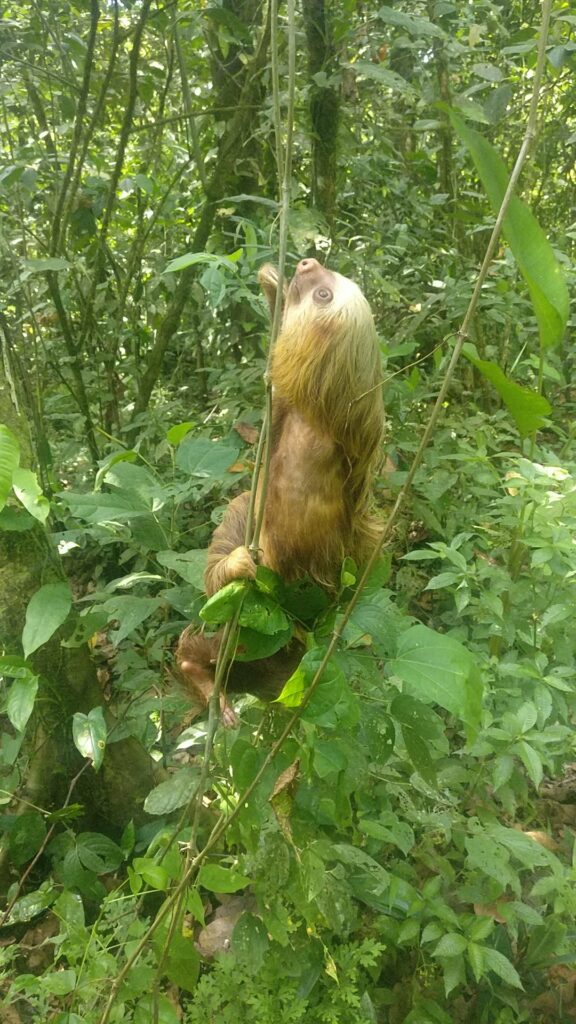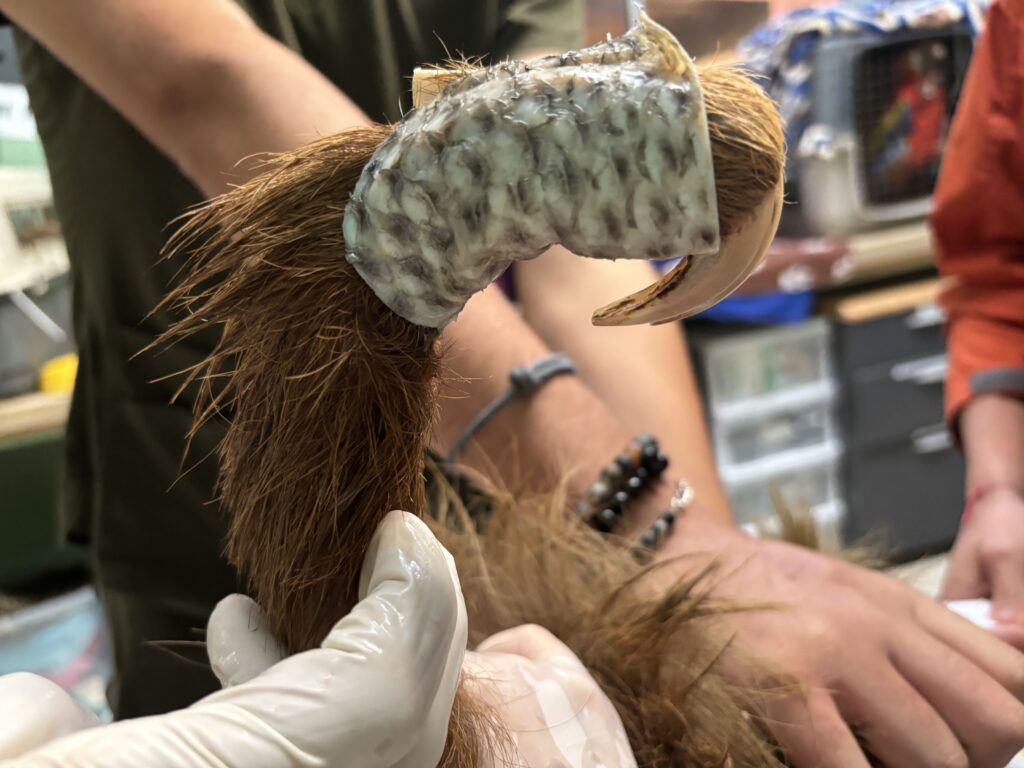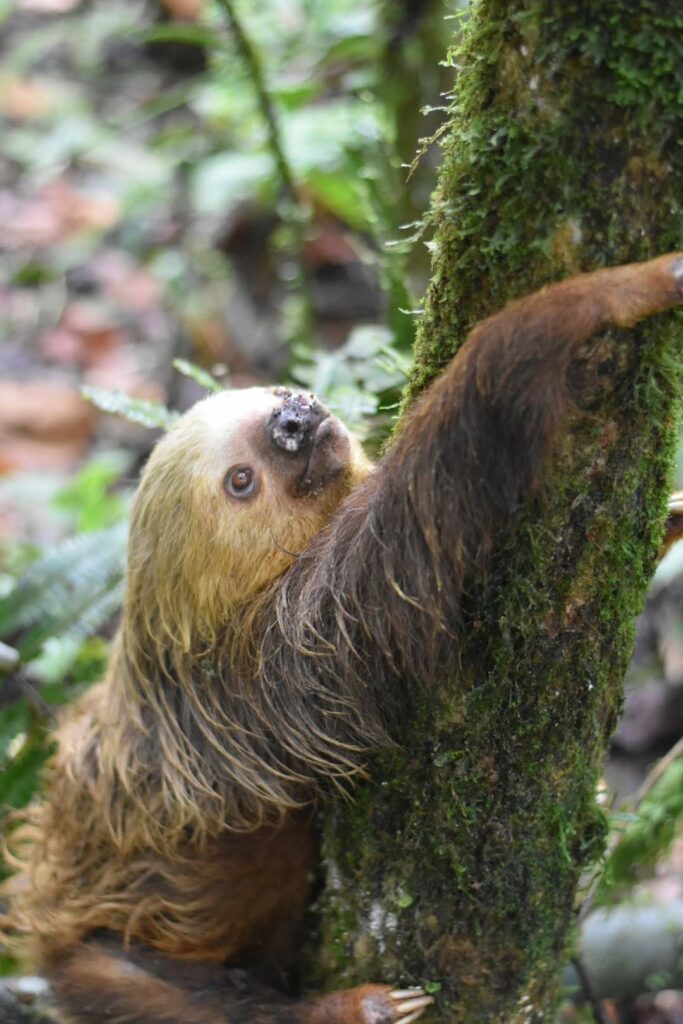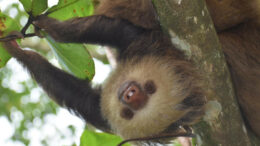Sloths are the darlings of the internet. Their mouths naturally turn up, making them look like they’re always smiling. They’re the embodiment of chill, with the slowest metabolism of any non-hibernating mammal. On social media posts, there are photos and drawing of sloths, many with humorous or encouraging sayings celebrating sloths’ slowness and sleepiness. “Slow down and enjoy life,” one reads.
Of course, the real lives of sloths aren’t so Instagrammable. Throughout the range of the seven sloth species in Central and South America, the animals face many challenges to their survival, including dog bites, getting hit by vehicles, and electrocution.
Each of these are the consequences of deforestation, says Adriana Aguilar Borbon, marketing and environmental education manager for Proyecto Asís Wildlife Sanctuary in San Carlos, Costa Rica and a member of the International Union for Conservation of Nature Species Survival Commission Anteater, Sloth and Armadillo Specialist Group.
Electrocution is one of the main reasons sloths are admitted to wildlife rescue centers, says Ana María Villada Rosales, a veterinarian at The Sloth Institute in Manual Antonio, Costa Rica. Sloths get electrocuted when they use uninsulated power lines to travel across the forest canopy, instead of branches and vines.
In one recent year, over 20% of the sloths treated at the Toucan Rescue Ranch in San Josecito, Costa Rica had electrocution injuries, according to Janet Sandi, its veterinary director. The actual number of electrocuted sloths is bigger than what her organization sees, Sandi says, because many of the sloths they treat are orphans whose mothers have died from their injuries.
Perilous Power
Road crossings are particularly perilous for sloths. Often branches are cleared away, leaving power and telephone lines as the only way to move over the road.
Sloths are not alone. All over the world, wildlife is electrocuted by powerlines. Scientific literature describes the electrocution of elephants in India; vultures in South Africa; macaws in Brazil; eagles in the United States, Argentina and Spain; and lots of primates.
“Pretty much everywhere there are monkeys, they get electrocuted,” says James F. Dwyer, a wildlife biologist who studies wildlife interactions with electrical equipment for the utility consulting firm EDM International in Fort Collins, Colorado.
It’s not just monkeys. The scientific literature describes the electrocution of primates such as langurs in India and Sri Lanka; Java slow lorises in Indonesia; Angolan black-and-white colobus, Sykes monkeys, white-tailed small-eared galagos, vervet monkeys, and northern yellow baboons in Kenya; and howler monkeys in Brazil.
Especially for smaller primates, electrocution from a power line is often fatal, Sandi says.
Other, even smaller, animals like squirrels can scamper down a bare electrical wire unharmed, Dwyer says, because electricity will only flow through an animal if it is touching two energized wires, or an energized wire and a path to ground. Sloths and primates are large enough to reach two uninsulated wires at the same time.
Transformers and cross-arms have connections that are closer together, allowing even small squirrels to touch two exposed wires, which is why squirrels are the most electrocuted animals in the United States — and the most common cause of power outages, according to Dwyer. But in most of the world, the cross arms of transmission poles are made of metal, he says, and sometimes the pole is made of metal too, providing even more opportunity for wildlife electrocution.
In some cases, electrocution deaths endanger a species. Electrocution is the leading cause of death in adult golden eagles, according to the U.S. Fish and Wildlife Service. In Kazakhstan recently, Dwyer saw photos of thousands of electrocuted saker falcons, listed as endangered on the IUCN Red List, under power lines across the steppe.
Saving Sloths Requires Innovation
The electrocution wounds sloths experience can be severe, burning away flesh to the tendons and even to the bone. If the burn reaches the bone, often an entire limb must be amputated to save the sloth’s life, sloth veterinarians say.

While in treatment, sloths belie their chill reputation. “These guys are really feisty,” Sandi says. “They can bite hard and cause infections. We usually need four people to hold them to give them an injection.”
But their slow metabolism means that sloths heal slowly. Bandage changes can be painful for the sloths, and because of both the sloths’ pain and the veterinarians’ safety, many sloths need to be put under anesthesia for each bandage change, which, for traditional bandages, typically happens daily. General anesthesia poses some risk to sloths, just as it does to humans.
Because of this, Sandi and Villada were intrigued when they learned that bears who had been burned in California’s 2018 Thomas fire healed more quickly, with fewer bandage changes, when treated with bandages made from the sterilized skin of a commonly eaten and farmed fish, the tilapia.
In the United States, people who suffer burns are often treated with donated human skin, pig skin or an artificial substitute. These materials are not widely available in places such as Brazil, which has innovated the use of sterilized tilapia skin to treat burns in humans.
Villada and Sandi wanted to have as much information as possible before trying the technique, so they thought about who in their local veterinary network had experience using tilapia skin bandages.
Meanwhile Isabel Hagnauer, a veterinarian at Rescate Wildlife Rescue Center in Alajuela, Costa Rica, was facing a similar issue with the sloths in her care. “Of the 14 two-toed sloths we treated in 2023, five had been electrocuted. We also cared for two baby two-toed sloths orphaned by electrocution.” In Hagnauer’s case, it was news about a burned mountain lion, from the same California fire, that made her eager to try tilapia skin bandages on recovering sloths.
For all three veterinarians, the Costa Rican colleague with the expertise they were looking for was Pricilla Ortiz, a veterinarian mostly working with dogs and cats who was so impressed with the benefits of tilapia skin on her patients that she started a company to sell the bandages.
“Using the tilapia skin, I was able to reduce the amount of antibiotics and analgesics [pain relievers] I was giving,” Ortiz says. “The best part was not having to stress the animals with bandage changes.”
The translation of the bandage techniques from dogs to sloths was not completely smooth. Some of the first two-toed sloths they bandaged with tilapia skin, Villada says, promptly ate the bandage. After that, the team put loose cloth bandages over the tilapia skin to eliminate bandage snacking.

On dogs, a tilapia skin bandage typically lasts about 10 days, Ortiz says. But Sandi and Villada noticed that some sloths were showing signs of infection after the tilapia skin bandages had been in place for as little as five days. The solution was simple: more frequent bandage changes. Even changing a bandage every five days was a huge improvement over changing them daily.
For veterinarians, and for everyone working at sloth rescue centers across their range, the biggest heartbreak of electrocuted sloths is that even when the animals’ external wounds are healing nicely, they often die after a few weeks of internal injuries, which may not show symptoms.
Of course, the best remedy would be to prevent electrocutions in the first place. In Costa Rica, several nonprofits erect rope bridges over roads to protect sloths and monkeys. In the United States, Dwyer says, California utility companies have found success with plastic covers for power lines, transformers and other power equipment in places where hawks and eagles get electrocuted.
Installing the covers is expensive, Dwyer says. While the covers themselves are low-cost, the expense of sending utility workers to remote locations is significant.
Aguilar says Proyecto Asís Wildlife Sanctuary has been successful working with communities in Costa Rica to report places where wildlife are being electrocuted and getting the power company to install protective plastic covers.
Saving Every Sloth
However, Aguilar believes that sloths’ internet popularity is a threat that overshadows all the threats that are bringing sloths to rescue centers. Veterinarians see the animals that die of electrocution, vehicle strikes and dog bites. What they don’t see, she says, is the sloths that die after being brought from table to table at tourist restaurants for $10 sloth selfies, while also being mistreated by their handlers. “When the sloth dies, they just get another,” she says.
Is the treatment of electrocution injuries helping sloths survive as species? While conservation biologists working with other species may disagree on the value of saving individual animals, sloth experts agree that every animal matters when there is so little known about these species.
While the pygmy three-toed sloth is critically endangered and the maned sloth is vulnerable, less is known about the four common sloth species that are currently considered “least concern” on the IUCN Red List.
“We don’t really know all that much about sloth populations,” says Monique Pool, founder and director of the Green Heritage Foundation and a member of the IUCN SSC specialist group for sloths and their kin. “I can only confidently say something about the sloth populations in greater Paramaribo,” Suriname’s capital city, where the Green Heritage Foundation is located. Pool feels some of the most commonly cited studies of sloth populations greatly overestimate their numbers.
“My biologist friends feel differently about the rescue and rehabilitation work that we do,” Pool says. “Our goal is to maintain viable sloth populations in urban areas. For us, every life matters.”
“Rehabilitation is part of conservation,” says Tinka Plese, founder and director of Aiunau, a Caldas, Columbia-based sloth, anteater and armadillo conservation organization and a member of the IUCN SSC specialist group for those animals. “Every animal we can return to the wild helps.”

Once it was thought that sloth amputees and sloths that had been in human care for longer periods could not be released into the wild. But both The Sloth Institute and Rescate Wildlife Rescue Center track the sloths they release and have found that many live long, healthy lives.
Hagnauer says a sloth that was released after a partial arm amputation has lived free within the rescue center’s 19 hectare (47 acre) grounds, often appearing with her babies, for nine years. Another popular sloth, nicknamed Don Lupe, was released in 2021 after a complete arm amputation and was recently seen in the wild.
Sloths that survive electrocution are creating a reputation for grit over chill. Sandi recalls a time when she placed a sloth that had just had surgery to amputate a limb near a tree in an enclosure at the Toucan Rescue Ranch. She went to get a cup of coffee, figuring it would be a long time before this slowest of mammals made a move. But when she came back, the sloth was gone.
She looked up, and there it was, in the branches. “I said, ‘Oh gosh, these guys are really strong.’”
Get more from The Revelator. Subscribe to our newsletter.
![]()
Previously in The Revelator:
How Social Media Supports Animal Cruelty and the Illegal Pet Trade


